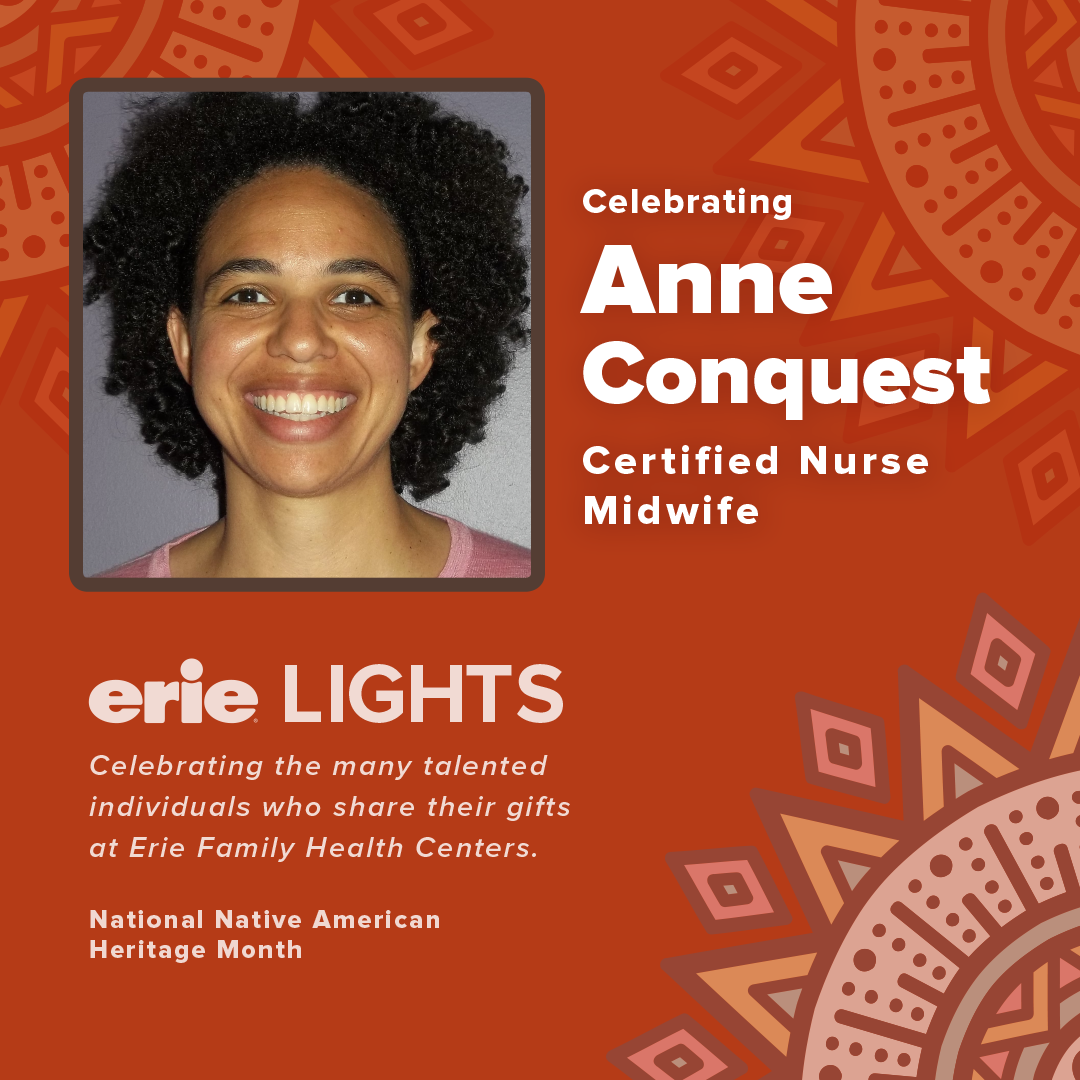
In observance of Native American Heritage Month, we recognize the contributions and sacrifice of Native Americans and the many ways that we can honor them. Annie Conquest Soule, a Nurse Midwife at Erie Foster Avenue and Erie Helping Hands Health Centers, worked on the Pine Ridge Reservation in South Dakota and Chinle Hospital on a Navajo reservation in Arizona before starting with Erie. Learn about Annie’s time serving patients at reservation hospitals and more in her Erie Lights profile.
What was your experience working on a reservation and what led you to these places?
Midwife students are required to do something called “integration.” We had to spend six months working with a midwife, doing full-scope practice, basically all the things a midwife would do. After finishing the classroom portion, I was assigned to the Pine Ridge Reservation in South Dakota. I spent under six months there, which solidified my interest in working with underserved folks. I developed a genuine love and appreciation for the Lakota Sioux, the tribes that lived on the Pine Ridge Reservation.
After working at the Park Ride Reservation, I worked at an Indian Health Service facility in Chinle, Arizona for two years before coming to Erie. The location is close to the Four Corners area, where Colorado, Utah, New Mexico, and Arizona meet. A Navajo reservation is a gigantic piece of land. There are various kinds of centers on that Navajo reservation, with multiple hospitals. The one I worked for happens to be one of the larger ones. It is right near Canyon De Chelly, which is like the Grand Canyon, but on a smaller scale, and it is an important spiritual location for Navajo people.
Part of the origin story of the Navajo people is that they came out of the Earth through a canyon. Some people believe that Canyon De Chelly is where the Navajo people first came to the Earth.
What lessons have you learned working with the Navajo people?
Most folks who have not been to that area of the country or have not spent any time there would be amazed at the conditions that Native people constantly live. For example, our hospital was around 200 miles from the houses of the people whom we cared for. Imagine being pregnant and having to travel that far for prenatal visits, or to go to the hospital when you are in labor. Think about what kind of planning challenges would present to any person. Some of the patients I worked with did not have electricity in their homes, either by choice or just because it was too far from the electricity lines.
A lot of that is the legacy of colonialism and our destruction of their culture. Another example is the lack of access to the tertiary care center. If somebody has a terrible accident, that meant putting them on an airplane and sending them to Flagstaff, Albuquerque, or Phoenix, Arizona. But that can only happen if the weather is good and if an aircraft is available. Those were things I never had to consider when working in a big city tertiary care center. Working on the Navajo reservation was a very humbling experience.
I also believe that the thing that was the most impressive to me was the resiliency of the people who worked and lived there. People valued their family time, their spiritual and living traditions over a lot of the oversized ticket items that the rest of us may think are necessary.
I know you have cared for many patients, but is there a patient that inspired you?
I had a young patient whose baby had a cleft lip and palate. It's usually caught on ultrasound during pregnancy, so you know, to anticipate it. But this is another example of the lack of high-quality ultrasound access. This patient did have an ultrasound, but they had not seen this cleft lip or palette. When the baby was born, I noticed right away what had happened. The nurse and I checked it out to see how severe the defect was. Once we evaluated this defect, we wrapped up and brought the baby over to her. I explained the birth defect to her but still clarified that she had a beautiful, healthy baby. I was prepared for her to have a negative reaction, but she handled it with such grace.
I admired her for it because I knew she was worried, and that it would be a long road of understanding the condition and travelling far distances for hospital visits. When things don't go right in my life, I try to remember the amount of grace and humility that she had when I handed her the baby. I want to be that person in the most challenging moments of my life.
What are the best practices to support Native Americans-Indigenous people within and outside of healthcare?
Recognizing that they were here first and that we have all benefited greatly from what was taken from them and what they gave us. We can also continue to protect their traditions. For example, when IHS was founded, there were a lot of mandates within the hospitals forbidding people from speaking their Native language in the hospital because it was alienating those who didn't speak their languages. That’s a perfect case of honoring that language is culture, and that if you don't allow somebody access to their Native language or use it, then you are stripping them, in some ways, of their culture and their ability to practice. You’re limiting their access to personal and spiritual practices.
What is an activity you enjoy doing during the Fall?
I would say apple picking with my kids because when you eat a fresh apple, you're like, 'Oh, my God, this is the thing.’ You finally understand that schoolteachers used to get apples as gifts because fresh apples are just the most delicious thing. The stuff we get from the supermarket the rest of the year is basically an unfortunate substitute for something exquisitely delicious.
How have your experiences working with Navajo people helped you better understand the significance of observances such as Native American Heritage Month?
My experiences helped me better understand the significance of these observances by recognizing the triumphs and struggles of groups historically marginalized or, in many ways, invisible in our larger culture. Also, recognizing them is a way of keeping them at the forefront and celebrating the strengths they bring to our culture.
